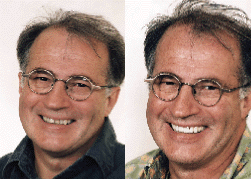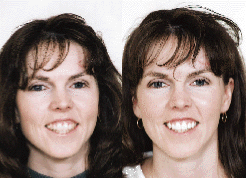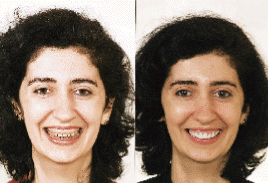The Classification of Smile Patterns
• Edward Philips, BA, DDS •
© J Can Dent Assoc 1999; 65:252-4
[Identifying Smile Patterns | Smile Styles |Smile Classification System |Summary | Reference]
When it comes to expressing emotions, members of widely different cultures have much in common. If people from various countries are shown a photograph of a happy, smiling face they usually agree in their interpretation. They also tend to concur over disgust, surprise, sadness, anger, fear and contempt. Such findings imply that beneath all the cultural complexity of mankind, there is a core of basic emotional expression that is understood all over the world.1,2 As best said by Darwin, it appears that we all smile in the same language.
Facial expressions have evolved over time, with changes in musculature around the mouth allowing for the development of new signals. For example, changes in the zygomaticus major, which moves the corners of the lips upward and backward, created our characteristic smile.1
Today, the smile is easily the most recognized expression, used to convey to our fellow human beings a sense of compassion and understanding. The smile may well be the cornerstone of social interaction.
As a result of this evolution, the smile necessitates a natural architectural pattern that is pleasing to others. Our responsibility as dentists is to face this new challenge and acquire the skills to identify various smile patterns. Only with proper pre-treatment diagnostics and a set of objectively measurable parameters can we begin to deal with rehabilitating our patients’ smiles.
Dentistry needs to develop a methodical classification to identify various smile patterns. Fundamental to our treatment are terms and classifications that standardize the myriad of individual dental problems and interpret them into vocabulary shared not only by patients and dentists, but by staff, laboratory personnel and regulatory bodies. Several branches of dentistry use classification systems; orthodontic occlusion, for example, is defined by a relatively simple three-type classification system. Similarly, periodontal furcations, traumatic tooth fractures and complicated oral facial surgeries are easily grouped and indexed.
Although there are millions of different smiles — essentially as many as there are individuals — three basic smile patterns can be identified. Plastic surgeons, tasked with rehabilitating smiles, have generally identified the following neuromuscular smile patterns:3
1. The commissure smile is the most common pattern, seen in approximately 67% of the population. In this smile, typically thought of as a Cupid’s bow, the corners of the mouth are first pulled up and outward, followed by the levators of the upper lip contracting to show the upper teeth. In this classic smile pattern, the lowest incisal edge of the maxillary teeth are the central incisors. From this point, the convexity continues superiorly with the maxillary first molar being 1 to 3 mm higher than the incisal edge of the centrals. A spontaneous smile results in a maximum movement of the commissure from 7 to 22 mm. Likewise, the average direction of movement of the commissure is 40 degrees from the horizontal (range 24 to 38 degrees). The direction of movement of most smiles is to the helix-scalp junction. When comparing the left to the right side, a large difference may exist in the extent of movement, but there is only a relatively slight discrepancy in the actual direction of movement when comparing left to right.4 Personalities with recognizable commissure smiles include Jerry Seinfeld, Dennis Quaid, Jennifer Aniston, Frank Sinatra, Jamie Lee Curtis and Audrey Hepburn.
2. The cuspid smile is found in 31% of the population.3 The shape of the lips are commonly visualized as a diamond. This smile pattern is identified by the dominance of the levator labii superioris. They contract first, exposing the cuspid teeth, then the corners of the mouth contract to pull the lips upward and outward. However, the corners of the mouth are often inferior to the height of the lip above the maxillary cuspids. Often there is a similar inferior turn of the maxillary premolars as opposed to the continuous convexity of a commissure smile. This "gull wing" effect is silhouetted by the gingival tissues, which correspondingly mimic the shape of the upper lip. In this smile pattern, the maxillary molars are often at or below the incisal edge of the central incisors. Eminent personalities with cuspid smiles include Elvis, Tom Cruise, Drew Barrymore, Sharon Stone, Linda Evangelista and Tiger Woods.
3. The complex smile characterizes 2% of the population.3 The shape of the lips are typically illustrated as two parallel chevrons. The levators of the upper lip, the levators of the corners of the mouth, and the depressors of the lower lip contract simultaneously, showing all the upper and lower teeth concurrently. The key characteristic of this smile is the strong muscular pull and retraction of the lower lip downward and back. In this smile pattern both maxillary and mandibular incisal planes are generally flat and parallel. Some celebrated personalities with complex smiles include Julia Roberts, Marilyn Monroe, Will Smith and Oprah Winfrey.
Although the basis for smile styles is neuromuscular, individuals can usually employ all smile patterns. Often a smile has been programmed by habit or by an inappropriate positioning of the underlying hard tissues. Restoring the smile can give individuals new confidence and can often change their neuromuscular programming.3
Stages of a Smile
There are four stages in a smile cycle:
Stage I l ips closed Stage II resting display Stage III natural smile (three-quarters) Stage IV expanded smile (full)
Of course, smiles vary and are unique to each individual. Many smiles do not differ much from a natural smile to an expanded smile. In these cases, treatment can often be restricted to the maxillary or mandibular anterior front six teeth. Other smiles have a very apparent discrepancy in display between these two stages, in which case, the treatment plan to esthetically improve the smile must be extended.5
Types of Smiles
There are five variations in which dental and/or periodontal tissues are displayed in the smile zone:
Type 1 maxillary only Type 2 maxillary and over 3 mm gingiva Type 3 mandibular only Type 4 maxillary and mandibular Type 5 neither maxillary nor mandibular
In the vast majority of cases, people will be categorized under a single type, although it is possible to combine types, if necessary. For instance, a patient may have a complex smile prominently showing maxillary and mandibular teeth and have a maxillary "gummy" smile displaying more than 3 mm of gingiva. This odd smile pattern would be a type 2, 4.
The above categories can be systematically combined to create a standardization of
terms objectively describing various smiles. Style, stage and type together provide a
complete, easy and concise description for smile classification. Patients and dentists
would both benefit from a nomenclature that is recognizable by definition. For example,
the most common smile is a commissure smile, stage III, type 1. Examples of each smile
pattern with corresponding classification can be seen in Figs. 1, 2 and 3.
 |
 |
| Fig. 1: Preoperative smile: Commissure, Stage III, Type 1. Postoperative: 15 porcelain veneers/crowns; Commissure, Stage IV, Type 1 | Fig. 2: Preoperative smile: Cuspid, Stage III, Type 4. Postoperative: 6 porcelain veneers; Cuspid, Stage III, Type 4. |
 |
| Fig. 3: Preoperative smile: Complex, Stage IV, Type 2. Postoperative: gingivectomy and 20 porcelain veneers; Commissure, Stage III, Type 1. |
Although "smile therapy" is still in its infancy, society has already placed a great demand on dentists to evaluate and treat smiles. The smile classification scheme and vocabulary presented in this article will aid in discussions between patient and dentist regarding esthetic treatment.
Acknowledgment: The author is grateful for his patients’ permission to reproduce the photographs used in this article.
Dr. Philips has a private practice in esthetic dentistry in Toronto.
Reprint requests to: Dr. Edward Philips, The Studio for Aesthetic Dentistry, 700 University Ave., Toronto ON, M5G 1Z5.
The views expressed are those of the author and do not necessarily reflect the opinion or official policies of the Canadian Dental Association
1. Young S. Human facial expressions. In: Jones, S. and others, editors. The Cambridge Encyclopedia of Human Evolution. 1992. p. 164-5.
2. Kingdon J. Facial patterns as signals and masks. In: Jones, S. and others, editors. The Cambridge Encyclopedia of Human Evolution. 1992. p. 161-5.
3. Rubin LR. The anatomy of a smile: its importance in the treatment of facial paralysis. Plast Reconstr Surg 1974; 53:384-7.
4. Paletz JL, Manktelow RT, Chaban R. The shape of a normal smile: implications for facial paralysis reconstruction. Plast Reconstr Surg 1993; 93:784-9.
5. Janzen EK. A balanced smile — a most important treatment objective. Am J Orthod 1977; 72:359-72.